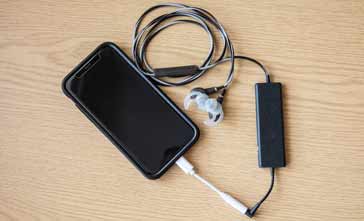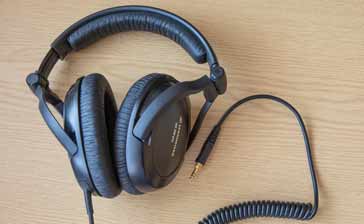Noise Cancelling Headphones & Earphones
Noise cancelling headphones and earphones are able to significantly reduce the effects of external noise and thereby greatly improve the listening experience.
Earphones, Headphones & Headsets includes:
Introduction to earphones & headphones
How do earphones / headphones work
Wireless / Bluetooth headphones & earphones
Noise cancelling headphones & earphones
Headphone specifications
How to buy best headphones / earphones for you
The use of active noise cancelling earphones and headphones has seen an enormous increase in recent years as they can help enhance the listening experience in noisy situations.
Listening to music whilst on public transport, on a train, or worst of all in an aeroplane can be difficult.
In aeroplanes the noise of the engines and the general noise of flying can make any form of listening very difficult. It is also one of the reasons why flying can be so tiring.
To make listening in noisy environments a far more enjoyable experience, it is possible to use noise cancelling headphones. In fact some people even use noise cancelling headphones to give them some quiet in a noisy environment without wanting to listen to music, etc.
In terms of the terminology, noise cancelling headphones may be referred to as noise cancelling headphones, or sometimes active noise canceling, ANC headphones.

Note the additional electronics unit for the noise cancelling electronics
Types of noise reducing headphones & earphones
There are different ways in which external noise can be reduced using headphones and earphones:
Passive noise reduction: It is possible to make a significant difference to external noise by simply employing the ear-cushion for the headphones, or with in-ear earphones by ensuring a suitable seal.
Typically the best noise reduction comes using headphones and a good ear-cushion. Not only does this make them more comfortable, but good noise reduction can be achieved.

Set of headphones that have good ear-cushions that will provide a good amount of sound insulation Although noise reduction can be achieved, it is not noise cancellation as this requires active measures to be employed. This approach will not provide the same level of noise reduction that noise cancelling headphones can provide.
The best passive noise-cancelling headphones are what are termed circum-aural types. These are specially designed to reduce external noise. The cushions provide a very snug fit and are designed for noise reduction and the backs of the headphones are also designed to reduce noise. That means they are packed with layers of high-density foam or other sound-absorbing material. This does make them heavier than other types of headphone, but they can provide noise reduction of about 15dB.
Active Noise Cancelling Headphones & Earphones: Active noise cancelling headphones and earphones are able to provide really significant levels of noise reduction by utilising active circuitry and using techniques to cancel out the noise. Although it is not possible to remove all the noise, very significant reductions can be made.
Although good levels of noise reduction can be achieved using ordinary earphones and headphones with good isolation, for the best noise reduction performance active noise cancelling headphones and earphones are the best.
There is a good selection of noise cancelling headphones on the market from a variety of manufacturers across the price range.
Basics of active noise cancelling headphones & earphones
The concept behind noise cancelling headphones is that the headphones sample the external noise. and then add the inverse of this to the signal to each earphone. The idea is that when two identical signals where one is inverted will cancel each other out.

The idea is that the earphone reproduces an audio signal of the unwanted noise that is equal and opposite to the noise being heard. The two signals will then cancel out, and only the wanted audio signal will be heard.
The simple example of two sine waves shows how the two signals cancel out.
So essentially, noise cancelling headphones use electronic processing to analyse the unwanted noise and then attempt to generate an equal and opposite sound to cancel out the unwanted noise. The result should be that there is less overall noise.
In order to be able to provide the noise cancellation , a number of components are needed within the headphones:
Microphone: A small suitably placed microphone placed picks up the external sounds that cannot be blocked passively. Some headphones use several microphones suitably placed so that they can get the best estimation of the noise that needs to be cancelled out. The placement is critical to getting the best performance.
Noise cancelling electronic circuitry: The signal from the microphone is fed to electronic circuitry that amplifies and processes the signal to create a that is 180° out of phase with the unwanted noise being heard by the users. This will be sued to counteract the unwanted noise that leaks through any ear cushions, etc. This "anti-noise" signal is then combined with the wanted material that the user wants to listen to. This provides a composite of programme material and anti-phase noise.
Headphone drive unit: The signal from the electronic circuitry is then converted into sound by the earphone transducer or drive unit.
Battery: As electronic circuitry is included within the headphones, a battery is needed to power this. Typically on-board lithium-ion batteries are used as these will give a god lifetime, often between about eight and 20 hours.
It is worth noting that for most active noise cancelling headphones dynamic drive systems are used. This is because the larger diaphragms they use are able to move larger volumes of air and can reproduce bass frequencies better and with a higher volume than other types. Most of the noise that is cancelled comes from the lower frequencies in the audio spectrum, and therefore an earphone driver that can handle higher level bass sounds is needed. In some instances, however, noise cancelling headphones or earphones may use a hybrid audio driver using a dynamic driver alongside a balanced armature one.
Using noise cancelling headphones
Noise cancelling headphones are very good in many instances. They can provide a significant improvement in lowering the ambient noise level.
In reality, noise cancelling headphones are not perfect - even the best ones will not eliminate all the noise, but they will reduce it. Often they will give around 20dB reduction which is quite significant.
They tend to work best with low frequency droning sounds. For example on an aeroplane they will significantly reduce the background noise and drone. It is also found that they do not work quite so well at higher frequencies.
Human voices and especially crying children are not completely eliminated, and door slams, etc are not reduced as much, but they still give a significant improvement over ordinary headphones. Often the perception is that the whole level of unwanted external noise and background sounds are considerably reduced, but the repetitive drone and noise by a greater margin.
It is worth remembering that using noise cancelling headphones will reduce your connection to what is around you. When walking down a street, for example traffic, people coming up behind you and the like will not be heard, and it is sometimes best to turn off the noise cancelling when walking out and about so that you have a better awareness of what is around.
Another point to remember is that the battery needs to be charged up before a period of use, especially when away from home, otherwise they may run out of power. That said most are charged via a USB cable and this means they could be charged from a power bank if needed.
It is also worth taking care of the batteries by not letting them become fully discharged as the lithium ion batteries used have a finite lifetime and when the batteries are passed their useful lifetime, it is not usual to be able to replace them.
What to look for when buying noise cancelling headphones
There is an enormous selection of noise cancelling headphones on the market today - the choice can be quite daunting when setting out to look for a set.
To try to make the decision process a little easier, we have put together a few points to consider with explanations of what they mean to help narrow down the field.
In-ear or over-ear: There is a good choice of both in-ear noise cancelling earphones and over-ear headphones. Both offer good performance. In-ear ones tend to be less obtrusive, and smaller to put away when you have finished using them, but the over-ear ones can sometimes offer a better experience, . . . and they could keep your ears warm if you are outside and it is cold.
Wireless connectivity: Many noise cancelling headphones also provide wireless connectivity. As there is already an electronics module on the headphones, it does not take a lot extra to add the wireless connectivity. Consider whether you want this or not: it will be more convenient to use them as most music sources have Bluetooth connectivity, but check that your music source has Bluetooth, and also remember that wireless headphones will be more expensive than non-wireless ones.
Battery life: One important aspect of any powered items is the battery life. There is no use in having a battery powered item if it always needs recharging. Battery life tends to be anywhere between about 8 and 30 hours. Also check that they can be charged using a standard USB connector. Some are now using the new USB-C connector whereas others use the older micro-USB. Check you have the right interface cable, or whether one comes wit the headphones.
External sound reduction: Some noise cancelling headphones will quote the degree of noise reduction they give. Unfortunately it is very difficult to make direct comparisons, because not all headphone manufacturers will quote specifications. As it various from one situation to the next, and one wearer to the next, any specification will be difficult to verify and it may not be true for all users. It is often for this reason that manufacturers do not quite figures. However it is expected that figures of 20 to 25dB or so should be achieved by most items.
Weight: It is worth comparing the weight of different headphones. You don'y want headphones that will weigh you down. This aspect can be particularly important if extended periods of listening are envisaged.
There are many variables with external noise cancellation, overall sound reproduction, and the comfort and feel of the headphones or earphones. As a result, it is best to see if you can try them out before buying to make sure they will be OK.
If that does not work, the recognised brands should work well. Cheaper offerings may be OK, but there is more risk, especially if you are a discerning listener and want the best quality. Although there are soem bargains to be had, it is generally true that you get what you pay for.
Noise cancelling headphones are great when on the move in noisy environments. They are particularly useful when on noisy trains, or especially when travelling by air. Here they can make air travel more tolerable by reducing the wearing drone and noise that adds to the stress of travelling. It is one of the many reasons why people can feel so drained after a long haul flight. Having noise cancelling headphones can reduce this.
Under these and many circumstances these headphones and earphones can be great to use. But be aware they can reduce the level of awareness of what is going on around you and this isn't always good.
 Written by Ian Poole .
Written by Ian Poole .
Experienced electronics engineer and author.
More Audio Video Topics:
HDMI
SCART
DisplayPort
DVI
Loudspeaker technology
Headphones & earphones
Bluetooth speakers
Stereo sound
Microphones
Audio compact cassettes
Vinyl record technology
Digital radio
DVB television
Return to Audio / Video menu . . .




